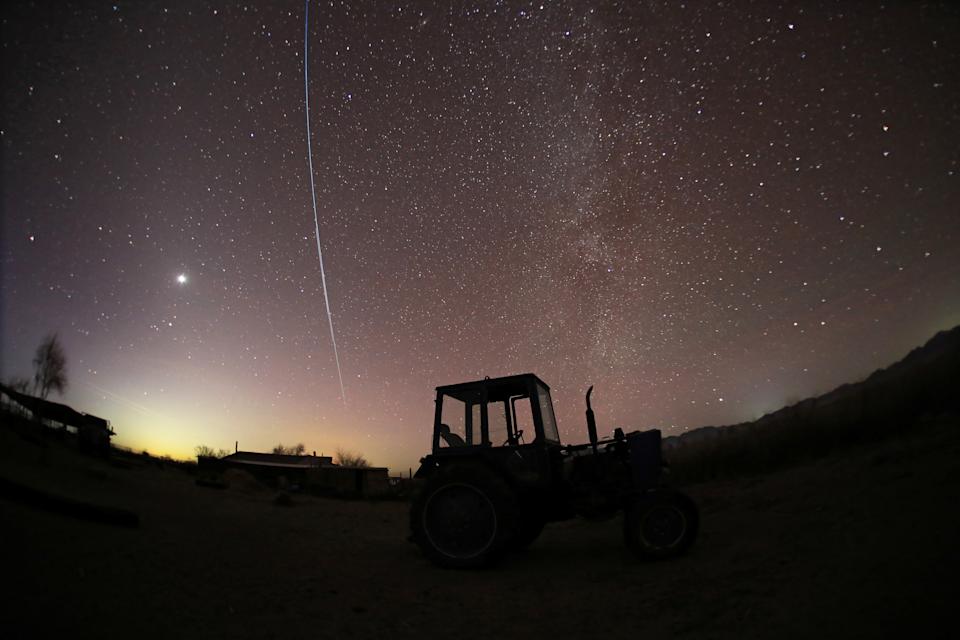Australian researchers are highlighting a frustrating problem in the skies above us as the growing number of satellites providing high-speed internet connectivity are having “unintended” consequences, potentially hindering our ability to understand the universe. Expansive new research has shown how the satellite technology of private companies like Starlink — increasingly relied upon by Aussies — is inadvertently interfering with the ability of researchers to study the depths of the cosmos.
The warning comes after astronomers in Western Australia undertook the world’s biggest study of low frequency satellite radio emissions. And it comes at a particularly critical time as construction continues in the state on what will become the world’s largest radio telescope — a massive project known as the Square Kilometre Array (SKA) that promises to help answer some of the biggest questions in the field.
“It’s going to be the largest radio telescope of all time, and it’s looking for very faint signals from the early universe,” PhD candidate and study lead Dylan Grigg told Yahoo News Australia.
“And so what we wanted to do was understand the prevalence of satellites at the frequencies that the Square Kilometre Array would be looking over.”
The researchers essentially took an image of the sky every two seconds for about a month, totalling some 76 million images.
“We detected a lot of satellites in the images. The overwhelming majority of those were Starlink satellites,” Grigg said. “And what we found was that they’re not transmitting at their designated downlink frequency, there’s some emissions coming from some electronics on board the satellites.”
At some frequencies about a third of the images were ultimately impacted, and the disturbance was observed at frequencies that are specifically set aside for radio astronomy. For instance, 703 satellites were identified at 150.8 MHz, which is meant to be protected for researchers in radio astronomy.
While Starlink, which had more than 7,000 satellites in low-Earth orbit during the period when the study was carried out, isn’t doing anything wrong, the devices “just happen to be [emitting] over frequencies that radio astronomers will want to be conducting science with the SKA,” Grigg explained.
Industry and academia clash as space fills up
Australians in regional areas have increasingly adopted Starlink’s internet services, with the company previously saying it has more than 200,000 local subscribers. While many residents in the bush rely on it for fast home internet, caravan travellers also take it on the road to stay connected at campgrounds and remote spots around the country.
The WA astronomers don’t dispute the boon the service provides, but hope the research will help lead to solutions to ensure scientists and private business can operate in harmony.
“We’ve had a dialogue ongoing with SpaceX about it. They’ve made good mitigations in the past for optical astronomy, like they’ve painted their satellites with a darker paint, and they’ve put visors up on them. So we’re hoping that by doing a study like this, we can continue the dialogue with them and hopefully see if we can get them to make some similar mitigations for radio as well.”
With Amazon launching satellites in a bid to compete with Starlink, and a raft of other companies launching their own satellites for various networks including emerging direct to mobile technology, low-Earth orbit is becoming an increasingly busy place.
“Starlink isn’t the only satellite network, but it is by far the biggest and its emissions are now increasingly prominent in our data,” Executive Director of the Curtin Institute of Radio Astronomy and study co-author Steven Tingay said in a statement.

Starlink satellites are pictured in the sky over a farm in Kazakhstan earlier this year. Source: Reuters
New SKA project puts astronomy on ‘edge of golden era’
Being assembled at more than 500 sites in the Australian outback and due to be finished by the end of the decade, the SKA will be the largest and most sensitive radio telescope on the planet. The international project has been likened to one of the world’s biggest science experiments that will be able to peer back into the earliest time of the universe.
“It’ll be a game-changer,” Grigg told Yahoo News.
Professor Tingay said it will help answer some of the most important questions we have.
“We’re standing on the edge of a golden era where the SKA will help answer the biggest questions in science: how the first stars formed, what dark matter is and even test Einstein’s theories,” he said.
“But it needs radio silence to succeed. We recognise the deep benefits of global connectivity but we need balance, and that starts with an understanding of the problem, which is the goal of our work.”
Their research highlighting the “unintended Starlink broadband emission on radio astronomy” in the SKA bands was published this month in the journal Astronomy and Astrophysics.
Love Australia’s weird and wonderful environment? 🐊🦘😳 Get our new newsletter showcasing the week’s best stories.


